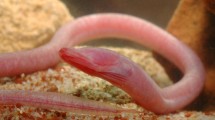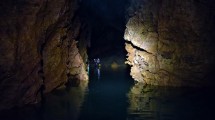Abstract
A new population of blind, cave dwelling tetra fish of the genus Astyanax was discovered in Granadas Cave, in the Balsas drainage, southern México. All blind Mexican tetras previously described are from Tampico and San Luis Potosí, northern México. The discovery of a new blind morph thus represents an independent colonization and convergent adaptation to the cave environment by this fish. Individuals of this population display variability of their troglomorphic features. Some individuals presented asymmetrical degeneration of the eyes, where one was normal, but the other somewhat reduced in size and complexity. Loss of pigmentation and eye reduction, although sometimes correlated, were not always linked; reduced eyes were found on pigmented fish and unpigmented fish often possessed normal eyes. Some individuals had reduced lens size or an absence of lens altogether. Retina is highly modified with photoreceptors sometimes absent. Eye reduction was correlated with a diminished size of the optic lobes and an increase of the prosencephalon. Modifications of the skull involve closing in of the circumorbital series of bones. Certain aspects of behavior are also modified.
Similar content being viewed by others
References
Breder, C.M. 1942. Descriptive ecology of La Cueva Chica, with special reference to the blind fish Anoptichthys. Zoologica 27:7–15.
Bussing, W.A. 1985. Patterns of distribution of the Central American ichthyofauna. pp. 453–473. In: F.G. Stehle & S.D. Webb (ed.) Topics in Geobiology, Vol. 4, Plenum Press, New York.
Contreras-Balderas, S. & M. de L. Lozano-Vilano. 1988. Problemas nomenclaturales de las formas mexicanas del género Astyanax (Pisces: Characidae). Zoología Inform (38): 1–13.
Eigenmann, C.H. 1917. The American characidae. Mem. Mus. Comp. Zool. 43: 1–558.
Espinasa, L. 1986. Exploraciones bioespeleológicas en Guerrero. Tepeyollotli. Gaceta SMES 1: 3–4.
Fack, H. & H. Wilkens. 1988. Eye reduction in hybrids and a naturally variable cave form of Astyanax fasciatus (Characidae, Pisces). Mém. Bioespéol. 15: 1–20.
Hubbs, C. 1938. Fishes from the caves of Yucatan. Carnegie Inst. Wash. Publ. 491: 261–295.
Langecker, T.G. & G. Longley. 1993. Morphological adaptations of the Texas blind catfishes Trogloglanis pattersoni and Satan eurystomus (Siluriformes: Ictaluridae) to their underground environment Copeia 1993: 976–986.
Mitchell, R.W., W.H. Russell & W.R. Elliot. 1977. Mexican eyeless characin fishes, genus Astyanax: environment, distribution, and evolution. Spec. Publ. Mus. Texas Tech. Univ. 12: 1–89.
Obregon-Barboza, H., S. Contreras-Balderas & M. Lozano-Villano. 1994. The fishes of northern and central Veracruz, México. Hydrobiologia 286: 79–95.
Parzefall, J. 1992. Behavioral aspects in animals living in caves. pp. 327–376. In: A.I. Camacho (ed.) The Natural History of Biospeleology, Museo Nacional de Ciencias Naturales, Madrid.
Romero, A. 1983. Introgressive hybridization in a population of Astyanax fasciatus (Pisces: Characidae) at La Cueva Chica. Nat. Speleol. Soc. Bull. 45: 81–85.
Romero, A. 1984. Behavior in an ‘intermediate’ population of the subterranean-dwelling characid Astyanax fasciatus. Env. Biol. Fish. 10: 203–210.
Romero, A. 1985. Ontogenetic change in phototactic responses of surface and cave populations of Astyanax fasciatus (Pisces:Characidae). Copeia. 1985: 1004–1011.
Romero, A. 2001. It's a wonderful hypogean life: a guide to the troglomorphic fishes of the world. Env. Biol. Fish. 62: 13–41 (this volume).
Schemmel, C. 1967. Vergleichende Untersuchungen an des autsinnesorganen ober-und unterirdisch lebender Astyanax-Formen. Z. Morphol. Tiere 61: 255–316.
Schemmel, C. 1980. Studies on the genetics of feeding behavior in the cave fish Astyanax mexicanus f. Anoptichthys. An example of apparent monofactorial inheritance by polygenes. Z. Tierpsychol. 53: 9–22.
Schmatolla, E. 1972. Dependence of tectal neuron differentiation on optic innervation in teleost fish. J. Embryol. Exp. Morphol. 27: 555–576.
Taylor, W.R. & G.C. Van Dyke. 1985. Revised procedures for staining and clearing small fishes and other vertebrates for bone and cartilage studies. Cybium 9: 107–109.
Trajano, E. 1987. Fauna cavernicola brasileira: composiçâo e caracterizaçâo preliminar. Rev. Bras. Zoologia 3: 533–561.
Wilkens, H. 1988. Evolution and genetics of epigean and cave Astyanax mexicanus (Characidae, Pisces). Support for the neutral mutation theory. Evol. Biol. 23: 271–367.
Author information
Authors and Affiliations
Rights and permissions
About this article
Cite this article
Espinasa, L., Rivas-Manzano, P. & Pérez, H.E. A New Blind Cave Fish Population of Genus Astyanax: Geography, Morphology and Behavior. Environmental Biology of Fishes 62, 339–344 (2001). https://doi.org/10.1023/A:1011852603162
Issue Date:
DOI: https://doi.org/10.1023/A:1011852603162




